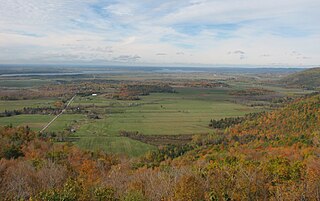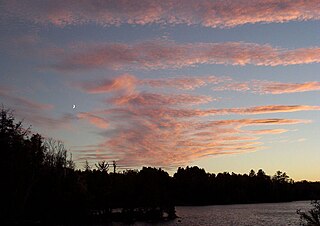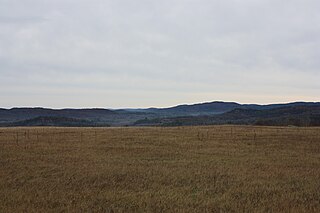
The Thousand Islands – Frontenac Arch region or the Frontenac Axis is an exposed strip of Precambrian rock in Canada and the United States that links the Canadian Shield from Algonquin Park with the Adirondack Mountain region in New York, an extension of the Laurentian Mountains of Québec. The Algonquin to Adirondacks region, which includes the Frontenac Axis or Arch, is a critical linkage for biodiversity and resilience, and one with important conservation potential. The axis separates the St. Lawrence Lowlands and the Great Lakes Lowlands. It has many distinctive plant and animal species. It is one of four ecoregions of the Mixedwood Plains.

The Algonquin people are an Indigenous people who now live in Eastern Canada. They speak the Algonquin language, which is part of the Algonquian language family. Culturally and linguistically, they are closely related to the Odawa, Potawatomi, Ojibwe, Mississaugas, and Nipissing, with whom they form the larger Anicinàpe (Anishinaabeg). Algonquins are known by many names, including Omàmiwinini and Abitibiwinni or the more generalised name of Anicinàpe.

The Ottawa Valley is the valley of the Ottawa River, along the boundary between Eastern Ontario and the Outaouais, Quebec, Canada. The valley is the transition between the Saint Lawrence Lowlands and the Canadian Shield. Because of the surrounding shield, the valley is narrow at its western end and then becomes increasingly wide as it progresses eastward. The underlying geophysical structure is the Ottawa-Bonnechere Graben. Approximately 1.3 million people reside in the valley, around 80% of whom reside in Ottawa. The total area of the Ottawa Valley is 2.4 million ha. The National Capital Region area has just over 1.4 million inhabitants in both provinces.
Rick Bartolucci is a former politician in Ontario, Canada. He was a Liberal member of the Legislative Assembly of Ontario from 1995 to 2014. He represented the riding of Sudbury and was a cabinet minister in the government of Dalton McGuinty.
Charles Jackson "Bud" Wildman is a Canadian politician. He served in the Legislative Assembly of Ontario as a New Democratic Party Member of Provincial Parliament (MPP) from 1975 to 1999, representing the riding of Algoma, and was a cabinet minister in the government of Bob Rae.

Kanesatake is a Mohawk settlement on the shore of the Lake of Two Mountains in southwestern Quebec, Canada, at the confluence of the Ottawa and Saint Lawrence rivers and about 48 kilometres (30 mi) west of Montreal. People who reside in Kanehsatà:ke are referred to as Mohawks of Kanesatake. As of 2022, the total registered population was 2,751, with a total of about 1,364 persons living on the territory. Both they and the Mohawk of Kahnawake, Quebec, a reserve located south of the river from Montreal, also control and have hunting and fishing rights to Doncaster 17 Indian Reserve.

Frontenac Provincial Park is a provincial park located near the town of Sydenham, north of Kingston, Ontario, Canada. This 5,350 ha (13,200-acre) park is classified as a natural environment park, and lies on the Frontenac Axis, a topographic extension of the Canadian Shield connecting to the Adirondack Mountains. It features 22 lakes, over 700 species, and extensive areas of mixed forest, wetlands, and granite outcrops.

Asubpeeschoseewagong First Nation is an Ojibwe First Nations band government who inhabit northern Kenora in Ontario, Canada. Their landbase is the 4,145 ha English River 21 Indian Reserve. It has a registered population of 1,595 as of October 2019, of which the on-reserve population was 971. As of October 2023, the community had a registered population of 1,608. They are a signatory to Treaty 3.

The Grand River land dispute, also known as the Caledonia land dispute, is an ongoing dispute between the Six Nations of the Grand River and the Government of Canada. It is focused on land along the length of the Grand River in Ontario known as the Haldimand Tract, a 385,000-hectare (950,000-acre) tract that was granted to Indigenous allies of the British Crown in 1784 to make up for territorial losses suffered as a result of the American Revolutionary War and the Treaty of Paris (1783). The Six Nations were granted the land in perpetuity and allege that lands were improperly sold, leased or given away by various Canadian governments, leaving only 5 per cent of the original lands under Six Nations control. The Six Nations also allege that monies owed to the Six Nations from leases and loans on much of the tract have not been paid or were redirected into government coffers.

Paudash Lake is a lake in south central Ontario southwest of Bancroft along Highway 28. The lake is located just north of Silent Lake Provincial Park in Haliburton County, 27 km (17 mi) south of the panhandle of Algonquin Provincial Park. The nearest communities to Paudash Lake are the village of Cardiff, close to the lake's Inlet Bay, and the hamlet of Paudash to the northeast of Lower Paudash Lake. Actually two lakes, 'Paudash' and 'Lower Paudash', the lakes are located on the Crowe River, near its head waters, which flows into the Trent River at Crowe Bay north of Campbellford.
Frontenac Ventures Corporation is a privately owned uranium mining and exploration company. Frontenac was formed to open a new mine in North Frontenac, Ontario. The mine was opposed by First Nations and other persons in the area, leading to a blockade, injunctions. The venture was abandoned after Frontenac Ventures failed to get funding for the project.
Canada has an active anti-nuclear movement, which includes major campaigning organisations like Greenpeace and the Sierra Club. Over 300 public interest groups across Canada have endorsed the mandate of the Campaign for Nuclear Phaseout (CNP). Some environmental organisations such as Energy Probe, the Pembina Institute and the Canadian Coalition for Nuclear Responsibility (CCNR) are reported to have developed considerable expertise on nuclear power and energy issues. There is also a long-standing tradition of indigenous opposition to uranium mining.

The Opeongo Hills are a range of hills in Southern Ontario, near Algonquin Provincial Park. The hills stretch from Opeongo Lake in Algonquin Park in the west, along the Madawaska and Opeongo Rivers, towards the Opeongo Colonization Road, and extending towards the Deacon Escarpment, Bonnechere, Ontario, and Dacre in the east. To the east of the Opeongo Hills lie the Madawaska River valley, the Mississippi River Valley, and the Ottawa-Bonnechere Graben along the Ottawa River. Its tallest peak is roughly 7 km northeast of Highway 60. At roughly 586 meters, it is the tallest point in Southern Ontario. The community of Foymount is one of the highest settlements in Southern Ontario.
The Shabot Obaadjiwan First Nation, formerly known as the Sharbot Mishigama Anishinabe Algonquin First Nation and as the Sharbot Lake Algonquin First Nation, is a non-status Algonquin (Anishinaabe) community located north of Kingston, Ontario. It is currently in negotiation with the federal and provincial governments over claims to Aboriginal title in the area. Its chief is Doreen Davis.

Paula Sherman is a Canadian writer, activist and educator. She is also a professor of Indigenous Studies at Trent University, in Peterborough, Ontario. Her recent book entitled Dishonour of the Crown: The Ontario Resource Regime in the Valley of the Kiji Sibi chronicles the Ardoch community's struggle to prevent uranium prospecting on their traditional lands and is published by Arbeiter Ring Publishing, Winnipeg, MB. She is also a contributor to Lighting the Eighth Fire: The Liberation, Resurgence and Protection of Indigenous Nations, a collection of essays writing by emerging Indigenous activists and academics edited by Mississauga academic Leanne Betasamosake Simpson.

Bruce Allan Clark is a Canadian native rights lawyer, writer and activist. He rose to attention as part of the Gustafsen Lake Standoff and its aftermath.

Sharbot Lake is a lake in the municipality of Central Frontenac, Frontenac County in Eastern Ontario, Canada. It is part of the Saint Lawrence River drainage basin. The eponymous community of Sharbot Lake is located at the centre of the north shore of the lake.

The Coastal GasLink pipeline is a TC Energy natural gas pipeline under construction in British Columbia, Canada. Starting in Dawson Creek, the pipeline's route crosses through the Canadian Rockies and other mountain ranges to Kitimat, where the gas will be exported to Asian customers. Its route passes through several First Nations peoples' traditional lands, including some that are unceded. Controversy around the project has highlighted divisions within the leadership structure of impacted First Nations: elected band councils support the project, but traditional hereditary chiefs of the Wetʼsuwetʼen people oppose the project on ecological grounds and organized blockades to obstruct construction on their traditional land. Wetʼsuwetʼen people opposed to the pipeline argue that they have a relationship with the land that the Coastal GasLink pipeline construction threatens.
The Algonquins of Ontario Settlement Area covers 36,000 square kilometers of land in eastern Ontario. The area is historically unceded land, and is an area with more than 1.2 million people.













